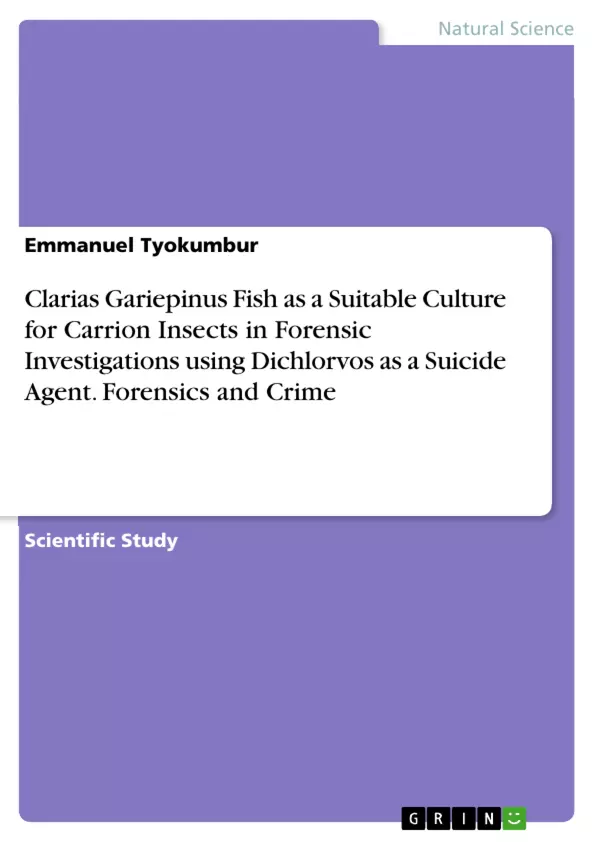A study was carried out on the forensic entomotoxicological evaluation of carrion insects of fishes poisoned with dichlorvos on the main campus of the University of Ibadan. Fishes (Clarias gariepinus) for the study were obtained from the fish farm on the University Campus. The fishes were then euthanized with 5ml of dichlorvos while the control was without poison. Adult carrion insects were collected from the fish carrion using a sweep net. The larvae were collected into a bowl by using a scoop, immobilized with hot water and later placed in sample bottles containing 70% ethanol. Pupae were collected using forceps. Carcass temperature was measured using infrared thermometer while relative humidity was recorded from a digital hygrometer. Calliphoridae and Muscidae were the initial pioneers of the decomposing carcass and were seen during the fresh stage, sarcophagidae was seen shortly after the fresh stage of decomposition. The highest mean temperature value for the fish treated with 5ml Dichlorvos was 31.30C while its lowest mean value was 22.60C. It was observed that the temperature on the ninth day was higher than the other days. This is attributed to the heat generated by the active maggots at that stage of decomposition. Dichlorvos was found to retard the growth of carrion larva as shown in Musca domestica larvae when compared with the control. Fast decomposition rate was recorded due to high ambient and carcass temperature. It can be concluded from this study that carrion insects can be used in solving crime puzzles through the extrication of post mortem intervals in conjunction with environmental variables. Since fish carrion in this study attracted a sizable number of carrion insects, it is recommended that fish be used in future forensic case and experimental studies.
Inhaltsverzeichnis (Table of Contents)
- CHAPTER ONE
- CHAPTER TWO
- LITERATURE REVIEW
- CHAPTER THREE
- MATERIALS AND METHODS
- CHAPTER FOUR
- RESULTS
- PICTURES OF CARCASS DECOMPOSITION STAGES IN THE STUDY
- CHAPTER FIVE
- DISCUSSION..
- REFERENCES.
- LIST OF TABLES
- Table 1 Abundance of forensically important insects collected from fish carcass treated with 5ml of Dichlorvos
- Table 2 Abundance of forensically important insects collected from control fish carcass
Zielsetzung und Themenschwerpunkte (Objectives and Key Themes)
This study investigates the potential of carrion insects associated with fish carrion poisoned with dichlorvos to contribute to forensic investigations. The study explores the impact of dichlorvos on insect development and decomposition rates. The research seeks to determine if carrion insects can be used to estimate the post-mortem interval in cases involving fish poisoning with dichlorvos.
- Forensic entomotoxicological evaluation of carrion insects on fish poisoned with dichlorvos
- Impact of dichlorvos on carrion insect development and decomposition rates
- Use of carrion insects in determining post-mortem interval in fish poisoning cases
- Importance of fish carrion in forensic entomology research
- Analysis of environmental factors (temperature, humidity) in the decomposition process
Zusammenfassung der Kapitel (Chapter Summaries)
Chapter one introduces the study and its significance in forensic entomology. Chapter two delves into existing literature on forensic entomotoxicology, focusing on the effects of various poisons on carrion insect development. Chapter three outlines the materials and methods used in the study, including the collection and analysis of carrion insects from poisoned and control fish. Chapter four presents the results of the study, including the abundance of insect species, decomposition rates, and the impact of dichlorvos on insect development. Chapter five discusses the implications of the findings, highlighting the potential use of carrion insects in forensic investigations involving fish poisoning with dichlorvos.
Schlüsselwörter (Keywords)
The study primarily focuses on the areas of forensic entomotoxicology, carrion insect ecology, and decomposition processes. Key terms include: dichlorvos, Clarias gariepinus, carrion insects, forensic entomology, post-mortem interval, decomposition rate, and environmental variables. The research highlights the potential of carrion insects as a tool for forensic investigation, especially in cases involving fish poisoning with dichlorvos.
- Quote paper
- Emmanuel Tyokumbur (Author), 2023, Clarias Gariepinus Fish as a Suitable Culture for Carrion Insects in Forensic Investigations using Dichlorvos as a Suicide Agent. Forensics and Crime, Munich, GRIN Verlag, https://www.grin.com/document/1366996



